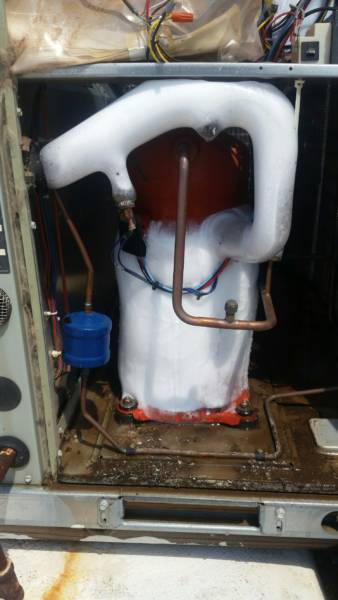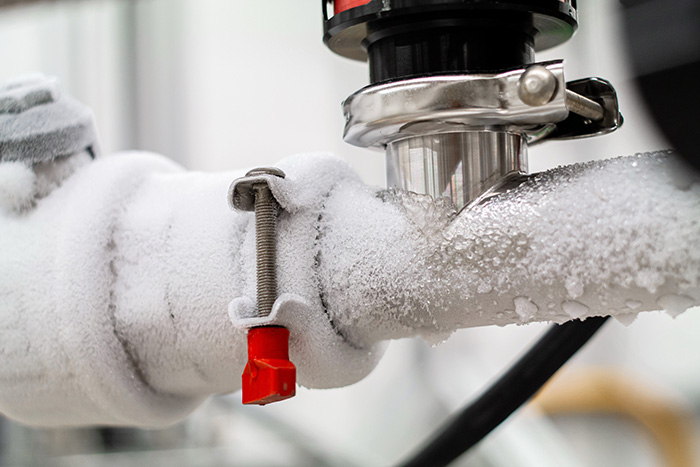Steps to Defrost the Frozen AC Pipe: Specialist Tips
Steps to Defrost the Frozen AC Pipe: Specialist Tips
Blog Article
Just how do you actually feel in relation to Air Conditioner Frozen? How To Fix your Frozen AC Line?

Introduction
Finding that your air conditioner pipeline is iced up can be concerning, especially throughout hot summer months when you depend on your air conditioning unit one of the most. Understanding what to do in such a circumstance is essential to avoid additional damages to your cooling system and guarantee your comfort inside your home.
Recognizing the Causes
A number of aspects can add to the cold of an air conditioning pipe. Comprehending these causes can assist you address the issue effectively.
Lack of Airflow
One common source of an icy AC pipe is inadequate airflow. When the air flow over the evaporator coil is restricted, it can create the coil to go down below freezing temperature, leading to ice development on the pipeline.
Low Refrigerant Levels
Inadequate refrigerant levels in your a/c system can likewise lead to an icy pipeline. Low refrigerant degrees can create the stress in the system to go down, causing the freezing of moisture on the evaporator coil.
Cold Weather Conditions
In colder environments, freezing temperature levels outside can contribute to the freezing of AC pipes. If your air conditioner device is not appropriately shielded or if there are leakages in the ductwork, chilly air can infiltrate the system, creating the pipe to freeze.
Dirty Air Filters
Dirty or clogged air filters can restrict airflow in your AC system, bring about numerous concerns, consisting of an icy pipeline. It's vital to change or clean your air filters consistently to ensure proper air flow and stop ice accumulation.
Indications of a Frozen Air Conditioning Pipe
Acknowledging the indicators of a frozen AC pipeline is essential for prompt action.
Reduced Airflow
If you notice a significant decrease in air movement from your vents, it could indicate a frozen pipeline.
Ice Buildup on the Pipe
Visible ice accumulation on the cooling agent line or the evaporator coil is a clear indicator of a frozen air conditioning pipeline.
Strange Sounds from the Unit
Unusual audios, such as hissing or bubbling, coming from your air conditioner device can signify that there's ice existing on the pipe.
Immediate Actions to Take
When faced with a frozen air conditioning pipe, it's essential to act promptly to prevent more damage to your air conditioning system.
Shutting off the air conditioner
The first step is to switch off your ac system to prevent the system from running and aggravating the issue.
Checking for Blockages
Evaluate the location around the indoor device for any type of obstructions that may be blocking air movement, such as furnishings or drapes.
Thawing the Pipe
You can make use of gentle approaches like putting towels soaked in cozy water around the frozen pipeline to help thaw it gradually.
Preventive Measures
Taking safety nets can help stay clear of future occurrences of an icy air conditioning pipeline.
When DIY Methods Fail
If your attempts to thaw the pipeline or address various other concerns are not successful, it's time to contact an expert.
Importance of Hiring a Professional HVAC Technician
A qualified HVAC professional has the expertise and devices necessary to identify and fix problems with your air conditioner system safely and properly.
Normal Maintenance Checks
Set up regular upkeep consult an expert HVAC service technician to make sure that your AC system is running effectively.
Transforming Air Filters
On a regular basis change or cleanse your air filters to avoid air movement constraints and preserve optimum efficiency.
Protecting Exposed Pipes
If your air conditioning pipes are subjected to cool temperatures, think about protecting them to avoid freezing during winter months.
Seeking Professional Help
If DIY methods fall short to resolve the issue or if you're uncertain regarding exactly how to continue, it's best to seek help from a qualified HVAC specialist.
Conclusion
Dealing with a frozen air conditioning pipeline can be a discouraging experience, but recognizing how to react can assist decrease damage and recover comfort to your home. By comprehending the reasons, recognizing the indicators, and taking prompt action, you can properly deal with the problem and prevent future events.
Frozen AC Line: Why It Happens & What To Do About It
A frozen AC line can be a rather peculiar sight in a place like Phoenix, Arizona where nothing ever freezes. In this post, we’ll discuss what makes an air conditioner line frozen – and what you can do about it.
Dirty Air Filters
Did you know that you should be cleaning or replacing your air filters on a monthly basis? Failing to do this can result in airflow issues that, in turn, cause your evaporator coils and lines to freeze over. You’ll notice a buildup of ice on both components, although the buildup on your pipes will, of course, be more evident unless you open your air condition up to reveal the coils.
What To Do About It
Give your air filter a good cleaning if it’s reusable. If not, replace the filter outright. Next, switch your air conditioner’s fan setting on and leave it there for 2-3 hours. This will draw warm air in, helping to thaw your evaporator coil. You can also check out this article for some tips on cleaning the coils themselves if you’d like to speed the process up. Before you switch the unit back to its normal state, make sure the supply vents are completely unobstructed and free of dust or other debris.
If you keep having this issue even after replacing your filters regularly, contact a local HVAC repair company and have them inspect your evaporator coil, ductwork, and any other components that may be at fault. If you live in the Phoenix, Arizona area, give American Home Water and Air a call.
Low Refrigerant Levels/Leakage
What To Do About It
Contrary to what air conditioner “recharge” companies often tell their clients about refrigerant, it should never need to be simply refilled. You see, refrigerant runs in what experts refer to as a “closed loop.” Refrigerant really shouldn’t be leaving that loop. If it is, you’ve got a leak.
Paying someone to come and pump more refrigerant into your system (aka “recharge” it) isn’t the solution. Doing that will simply kick the can down the road. Besides, refrigerant leaks can be harmful to the environment and people in your home.
Rather, you need to take care of the leak with the help of a technician. Check out this article for some more information about dealing with air conditioners that are leaking refrigerant. Before you contact a technician, switch your thermostat to the off position. Then, switch the fan setting on and let it run for 2-3 hours so the unit can thaw.
Improper Temperature Setting
Improper temperature settings can also cause a drop in your air conditioner’s pressure. What many people don’t realize is that air conditioners are actually designed to run when temperatures have fallen above roughly 60 degrees Fahrenheit. If you run the unit when it’s cold outside, you’ll run into many issues, including frozen components.

As a keen reader on How can I fix an air conditioner’s frozen pipe?, I imagined sharing that excerpt was beneficial. Loved our write up? Please share it. Help someone else discover it. I enjoy reading our article about Have a Frozen AC Line? Here’s How to Fix It.
Explore Report this page